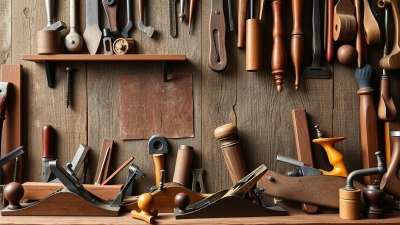Building a Collection of Local Vintage Tools from Markets
Discover how to start your collection of vintage tools from local markets and what to look for.

Image created with Flux Schnell
Collecting vintage tools is a rewarding hobby that allows enthusiasts to connect with history, craftsmanship, and the thrill of the hunt. Whether you're a woodworking aficionado, a restoration expert, or simply someone who appreciates the beauty of old tools, there’s a unique community surrounding vintage tool collecting. This guide will help you navigate local markets to build your collection while avoiding common pitfalls.
Understanding the Appeal of Vintage Tools
Vintage tools often represent craftsmanship and quality that can be lacking in many contemporary versions. Tools like hand planes, chisels, and saws from eras gone by are often made from better materials and offer superior functionality. For many collectors, each tool has a story to tell, connecting them to the past and the skilled artisans who originally used them. Additionally, vintage tools can be aesthetically pleasing, often featuring beautiful wood and metalwork, making them not just functional items, but works of art.
Starting Your Collection
Embarking on your journey to collect vintage tools requires planning and some basic knowledge. Here are a few steps to get started:
- Research: Familiarize yourself with different types of tools. Identify brands, models, and features that resonate with you. Consider focusing on specific categories, such as woodworking tools, gardening implements, or mechanics’ tools.
- Set a Budget: It’s easy to get carried away when you discover a treasure trove of tools. Set clear financial limits to avoid overspending, especially since vintage tools can vary dramatically in price.
- Join Collectors’ Groups: Engaging with local or online collectors’ groups can provide invaluable resources. These communities often share insights, recommendations, and even alerts about upcoming market events where you might find rare tools.
- Visit Local Markets: Identify markets in your area that specialize in antiques, flea markets, or garage sales. Even general markets can yield surprises. Always keep an eye out for both well-known vintage shops and smaller, independent sellers who may have unique items.
What to Look For
When you’re at markets, knowing what to look for can make all the difference. Here are key factors to consider:
- Condition: Assess the condition of the tool. Look for rust, cracks, or missing components. Some wear and tear can be expected, but significant damage can affect both usability and collectibility.
- Maker’s Mark: Check for the maker’s mark. Renowned brands typically fetch higher prices but also signify quality. Some recognizable names include Stanley, Millers Falls, and Snap-on.
- Age: Age can add value. Research the history of different tools to determine their age and context. Tools that are pre-WWII are often considered more valuable amongst collectors.
- Functionality: Remember to consider how much use you want your tools to have. While many collectors focus on display pieces, some prefer functional tools they can use in their own projects.
- Provenance: If possible, inquire about the history of the tool. Tools with documented provenance or a unique backstory can be particularly desirable.
Building Relationships with Sellers
Building relationships with local sellers can enhance your experience as a collector. Establishing trust can lead to better deals, insider knowledge about upcoming sales, and even leads on rare finds. Here are some strategies:
- Be Friendly: Approach sellers with a smile and genuine interest in their items. Ask questions and engage in conversations; this often leads to better outcomes.
- Return Visits: Frequent visits to the same sellers can help you establish a rapport. Sellers may inform you when new items arrive or allow you to preview items before they go public.
- Negotiate: Don’t be afraid to negotiate prices if they seem high. Most sellers expect haggling, especially in flea market settings. However, be respectful in your approach, as improper negotiation can damage relationships.
Storage and Maintenance
Once you have begun your collection, proper storage and maintenance are crucial. Tools that are well cared for retain their value and functionality. Here are some key tips:
- Environment: Store tools in a dry environment to prevent rust and deterioration. Consider using silica gel packs or moisture-absorbing products in your storage areas.
- Cleaning: Regularly clean your tools. Use oil on metal components to inhibit rust. Wooden handles can be treated with mineral oil to keep them from drying out and cracking.
- Display: If you choose to display your tools, consider shadow boxes or dedicated shelving that showcases their beauty while keeping them protected from dust and damage.
Adding Value to Your Collection
Growing the value of your collection involves a combination of knowledge and strategy:
- Investment: Consider the potential investment aspect of your tools. Some tools may appreciate in value, particularly if they are rare or in excellent condition. Research market trends to stay informed.
- Documentation: Keep a detailed log of your collection, including photographs, purchase details, and any relevant history. This information can be valuable should you choose to sell or trade items in the future.
- Networking: Attend vintage tool shows, join clubs, and connect with fellow collectors to stay updated on the latest trends and market values.
Participating in Tool Shows and Fairs
Participating in vintage tool shows and fairs can greatly enhance your collecting experience. These events offer opportunities to meet likeminded enthusiasts, learn from experts, and expand your collection:
- Find Events: Look for regional and national events that focus on vintage tools or antiques. Many towns hold annual fairs that draw a variety of sellers.
- Exhibit Your Collection: If you feel comfortable, consider exhibiting your own tools. Sharing your collection with others can garner feedback, insights, and even potential buyers for duplicates.
- Workshops: Many shows offer workshops on restoration, maintenance, and woodworking techniques. These can significantly enhance your knowledge and skills.
Navigating the Online Market
Though local markets are fantastic for finding vintage tools, the online marketplace has largely expanded collectors’ reach. Platforms like eBay, Etsy, and specialized vintage tool websites can connect you to items that may be hard to find locally. Here are some tips for successful online collecting:
- Review Seller Ratings: Always check ratings and reviews to understand the reliability of sellers. Look for those who specialize in tools and have good feedback.
- Research Prices: Know the market prices before making a purchase. This prevents overpaying for items and allows you to identify good deals.
- Ask Questions: Don’t hesitate to reach out to sellers for additional details or clarifications on tools. Serious sellers will appreciate your interest and should provide more information.
Building a collection of local vintage tools is a journey that combines history, skill, and community. By being knowledgeable and patient, you can uncover wonderful pieces that enrich your experience as a hobbyist or collector. Remember that each tool tells a story, and as you grow your collection, you become part of that narrative—one that honors craftsmanship and pays homage to the talented artisans of the past.
As you continue exploring local markets, connecting with sellers, and participating in collector communities, your collection will not only grow numerically but also culturally, acting as a tangible link between personal craftsmanship and a broader historical context. Happy collecting!











